Kimchi Gyoza Nabe is a Korean-inspired Japanese hot pot filled with succulent Japanese dumplings, spicy kimchi, tender vegetables, and hearty mushrooms. It’s a simmering bowl of savory deliciousness!
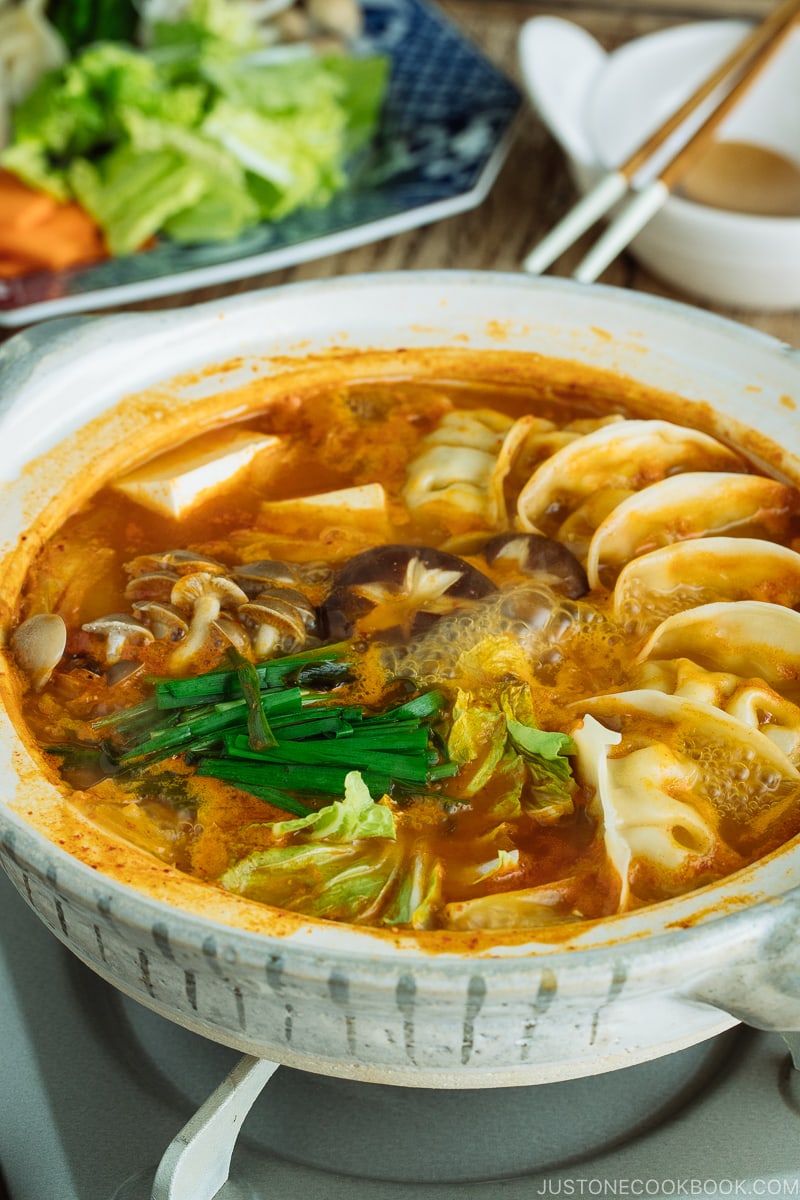
Kimchi Gyoza Nabe (キムチ餃子鍋) is a comfort dish filled with Japanese ingredients cooked in a Korean-inspired, spicy kimchi base. I love it since you can quickly throw in gyoza (Japanese dumplings), tofu, vegetables, and mushrooms to make this hot and sour soup.
This hot pot is packed with flavorful ingredients and it’s a perfect dish all year round when you need that satisfying kick of spice to warm you up.
Table of contents
What is Gyoza Nabe?
In a nutshell, Gyoza Nabe (餃子鍋) is like a dumpling (wonton) soup, except the dumpling here is Japanese gyoza. If you search Gyoza Nabe in Japanese, there are many variations – with different types of soup broth and different hot pot ingredients. Since this dish is not considered “traditional” Japanese food, make it with your favorite Japanese ingredients!
This Gyoza Nabe is totally my version that I came up with on a whim (but don’t worry, I have tested it a few times to make sure this recipe will absolutely hit the spot). Instead of a simple clear broth commonly used in Japanese hot pot, my recipe features a delicious spicy broth that richly infuses its flavor into the savory ingredients. You can also make this Gyoza Nabe with a kimchi soup base, or try one of these variations that might be fun for you to discover.
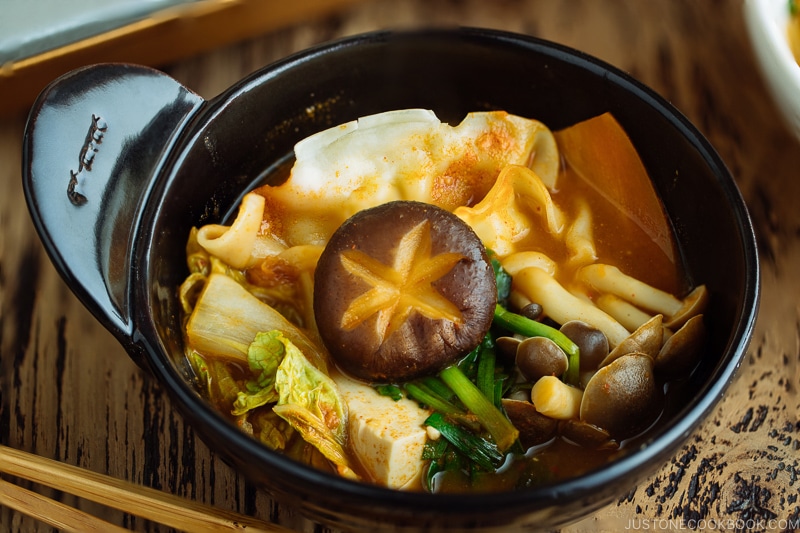
Soup Variations
Soup base:
- Awase dashi
- Kombu dashi (vegetarian and vegan)
- Chicken broth
Flavor Variations:
- Kimchi
- Miso
- Soy sauce
- Soy milk
- Tomato and more!
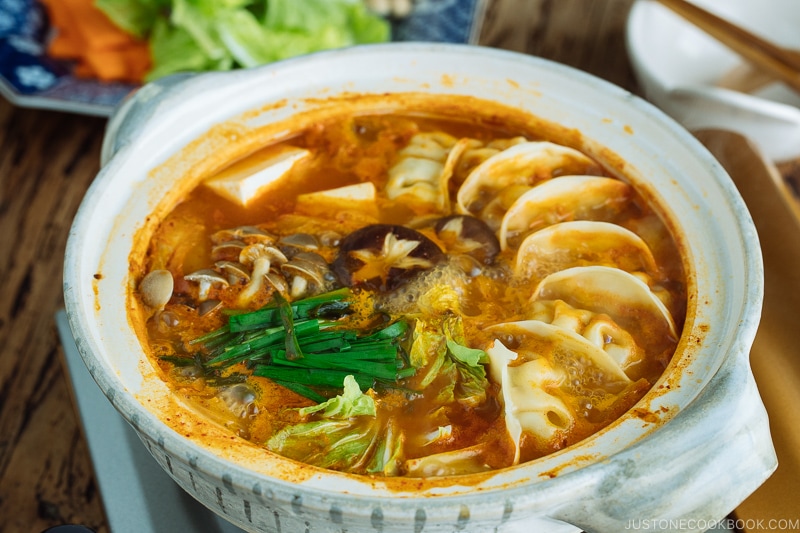
Hot Pot Ingredient Ideas
- Gyoza (pork, chicken, vegetables) (homemade gyoza recipe and gyoza wrapper)
- Meat – pork belly, thinly sliced beef/pork loin, meatballs, and chicken wings
- Tofu
- Fish cakes – chikuwa and kamaboko
- Napa cabbage
- Chinese chives (garlic chives)
- Shungiku (tong hao or garland chrysanthemum)
- Carrot
- Negi (long green onion) or green onions
- Leeks
- Bok choy
- Bean sprouts
- Shirataki noodles
- Mushrooms – shiitake, enoki, and shimeji
- Ramen noodles or steamed rice for enjoying the flavorful leftover soup!
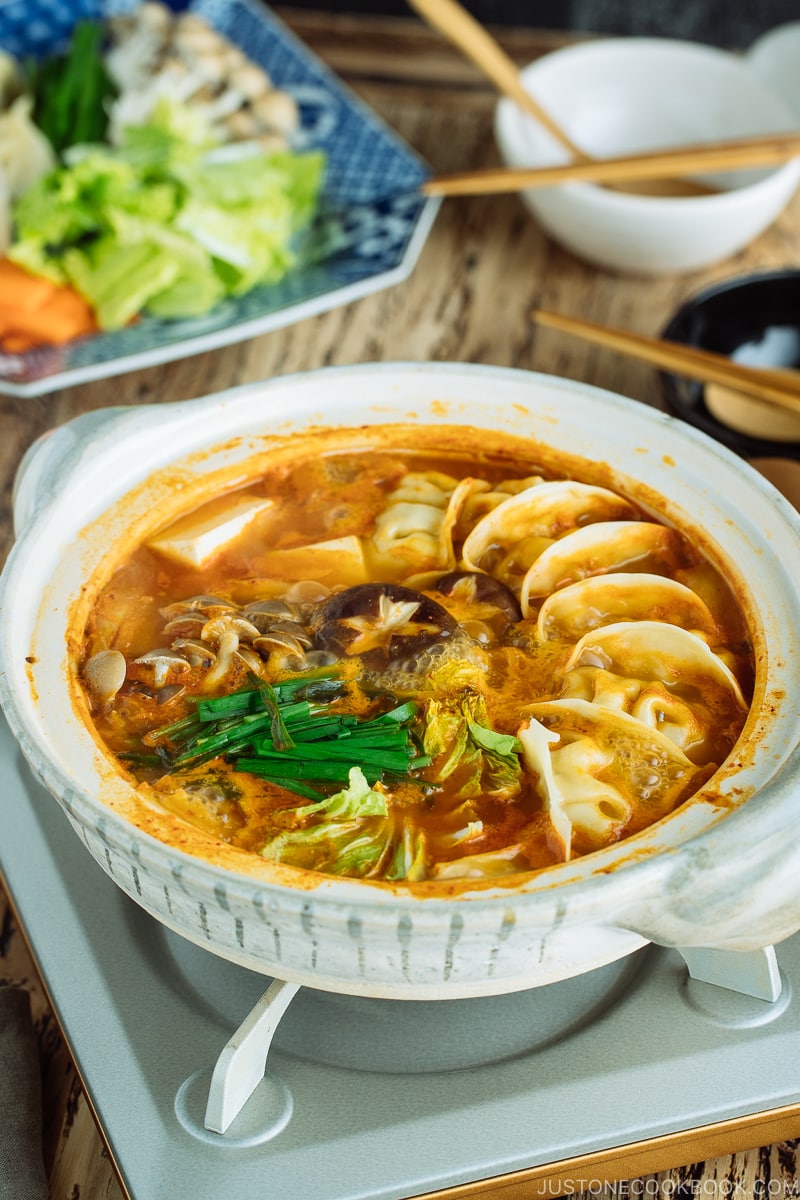
Cooking Tips
1. Dissolve miso completely
When you work with miso in a soup dish, make sure to completely dissolve miso in a ladle first before releasing miso into the soup. If you drop miso paste in the big pot of soup, you won’t know if the miso has been completely dissolved. You may end up adding more miso thinking that the soup doesn’t have much taste. Also, each brand of miso has a different level of saltiness, so please always taste the soup and adjust the flavor according to your liking.
2. Cook the dense ingredients first
If you want to enjoy the hot pot with all the ingredients being cooked at the right texture, you have to cook in 2 separate stages. Throw in root vegetables first, and then add in leafy vegetables when dense ingredients are almost tender. This way both the leafy vegetable and root vegetables will retain their proper texture. Another tip is to cut the ingredients into similar thicknesses and sizes so they’ll take roughly the same amount of time to cook.
3. Don’t overcook the gyoza
Whenever I make this, it’s a “fast food” recipe that I can make very quickly to feed my family. For me, I almost always use frozen gyoza – either homemade gyoza which I keep in the freezer or pre-made frozen gyoza from the grocery stores (Trader Joe’s has frozen pork or chicken gyoza which we like).
You don’t need to defrost, just add the frozen gyoza in the hot soup. Remember to add gyoza when all the ingredients are almost cooked through. Don’t cook the gyoza too long as the gyoza skin gets soggy when it’s soaked in the soup for too long. The overcooked gyoza skin could break easily and its filling may slip out.
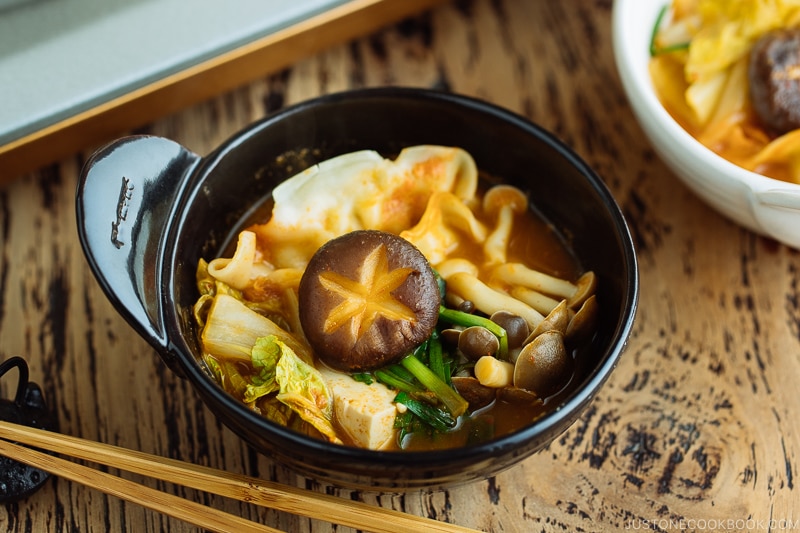
How to Enjoy Kimchi Gyoza Nabe
We enjoy the hot pot placed on the portable gas stove set at the dining table. It’s fun to eat and cook at the table as you can have a conversation with your family or friends while enjoying delicious food. For this recipe, there will be plenty of soup available for you to make it into a noodle soup by adding ramen noodles to the broth. You can also add steamed rice to go with the spicy soup.
If you don’t have a donabe, Japanese earthenware pot, you can make this dish in a regular pot. So what are you waiting for? Simply chop the veggies and throw in gyoza and you’ll have a mouth-watering meal ready in 30-40 min from start to finish. You’ll be surprised by how easy it is to put together this scrumptious meal. Enjoy!
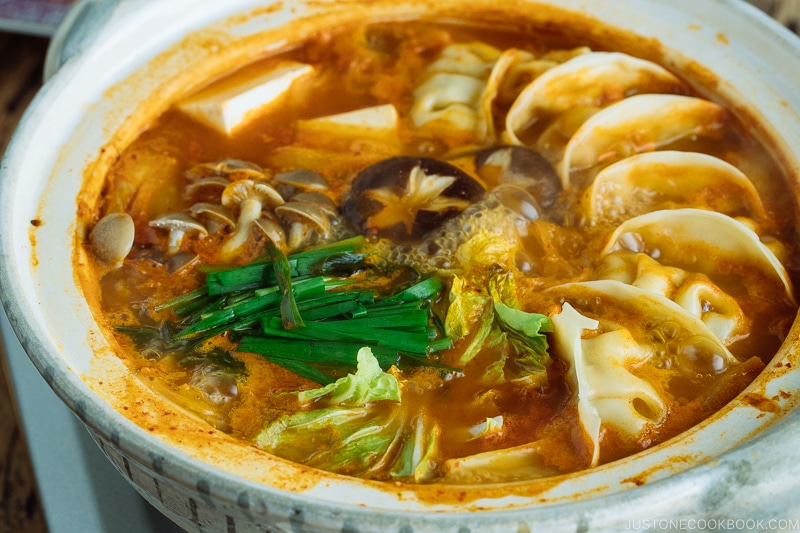
Wish to learn more about Japanese cooking? Sign up for our free newsletter to receive cooking tips & recipe updates! And stay in touch with me on Facebook, Pinterest, YouTube, and Instagram.
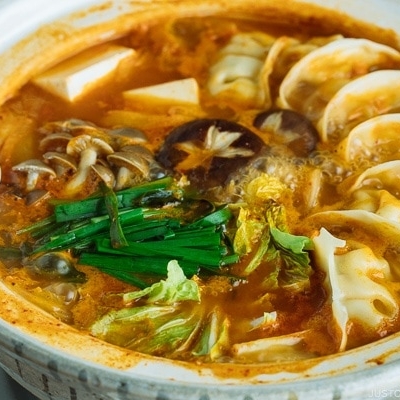
Kimchi Gyoza Nabe
Video
Ingredients
- ¼ onion
- 1 Tokyo negi (naga negi; long green onion)
- 4–6 leaves napa cabbage
- 1–2 inches daikon radish
- 2 inch carrot
- 5 stalks garlic chives (Chinese chives or Nira)
- 1 package shimeji mushrooms (3.5 oz, 100 g)
- 2 shiitake mushrooms
- 7 oz soft/silken tofu (kinugoshi dofu) (½ block)
- 2 tsp toasted sesame oil
- 10 pieces gyoza (I used frozen gyoza; or make my homemade Gyoza recipe)
For the Hot Pot Soup
- 1 cup kimchi (for vegan kimchi, you can make my friend Seonkyoung‘s recipe)
- 1 Tbsp sake
- 2 tsp gochujang (Korean chili paste)
- 1 tsp gochugaru (Korean pepper flakes)
- 2 tsp sugar
- 4 cups chicken stock/broth (use kombu dashi or shiitake dashi for vegan/vegetarian)
- 2 tsp soy sauce
- 2 Tbsp miso
- ¼ tsp Diamond Crystal kosher salt
Instructions
- Gather all the ingredients.

- Cut ¼ onion into wedges and then cut them half.

- Cut the white part of 1 Tokyo negi (naga negi; long green onion)

- Cut 4–6 leaves napa cabbage into small pieces.

- Cut 1–2 inches daikon radish into quarters lengthwise then thinly slice them.

- Cut 2 inch carrot into thin slabs and cut them in half.

- Cut 5 stalks garlic chives (Chinese chives or Nira) into 2-inch (5-cm) pieces.

- Discard the bottom of 1 package shimeji mushrooms and 2 shiitake mushrooms. Optionally, you can cut a flower pattern on the shiitake mushroom caps called shiitake hanagiri.

- Cut 7 oz soft/silken tofu (kinugoshi dofu) into roughly 1½-inch (4-cm) cubes. Tip: It’s harder to fish out from the hot pot if you cut the cubes too small.

- Heat 2 tsp toasted sesame oil in a hot pot over medium heat. Add the onion and cook until it’s coated with the oil.

- Add 1 cup kimchi and stir-fry with the onion and Tokyo negi.

- Add 1 Tbsp sake and 2 tsp gochujang (Korean chili paste).

- Add 1 tsp gochugaru (Korean pepper flakes) and 2 tsp sugar. Mix it all together well.

- Add 4 cups chicken stock/broth, and cover the lid to bring to simmer.

- Once simmering, lower the heat to medium low. Add 2 tsp soy sauce and 2 Tbsp miso. It’s best to dissolve the miso in a ladle with a small amount of soup first instead of dropping the miso in the pot and not know if it has dissolved completely. Taste the soup and adjust the taste by adding salt (I added ¼ tsp Diamond Crystal kosher salt), if necessary.

- Add the hard vegetables to the soup first, such as the daikon, carrot, tough part of napa cabbage, etc. Cook covered for 10 minutes on low heat.

- Skim off the foam and fat. Add the soft ingredients such as the leafy part of the napa cabbage, mushrooms, and tofu.

- Add 10 pieces gyoza (if frozen, no need to defrost) and the garlic chives on top.

- Cook covered over medium low heat for 5 minutes. Serve the extra ingredients on a plate and add them once you finish the ingredients in the pot.

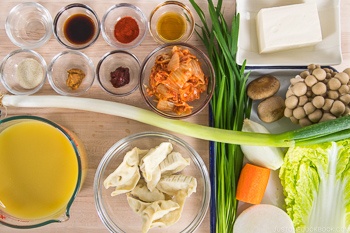
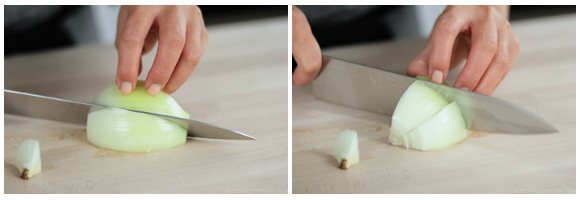
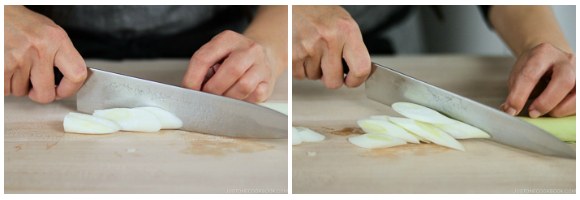
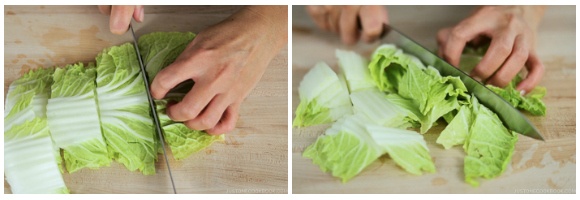

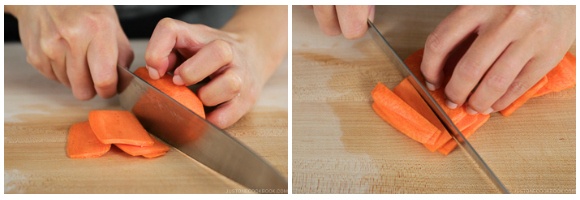
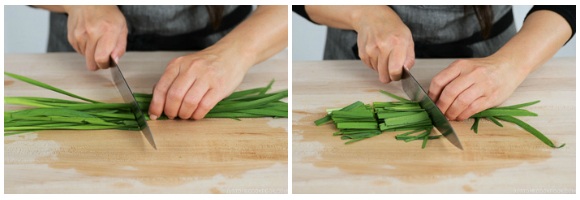

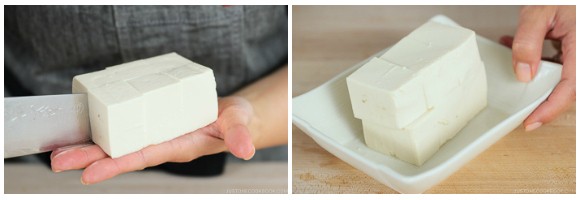
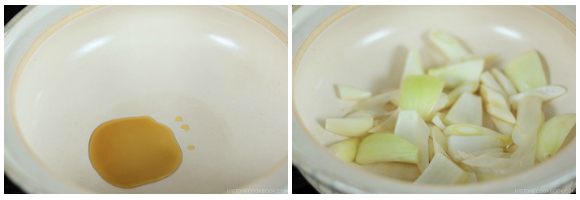
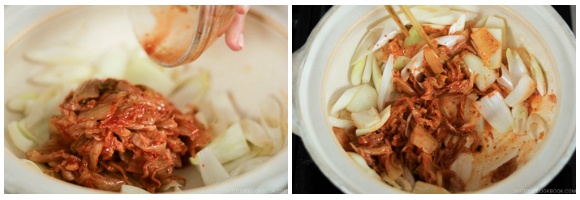
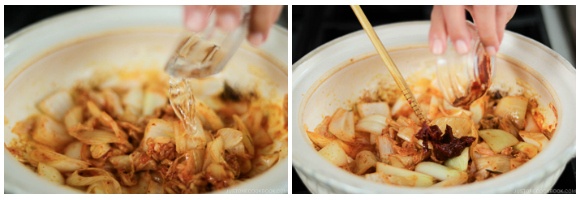
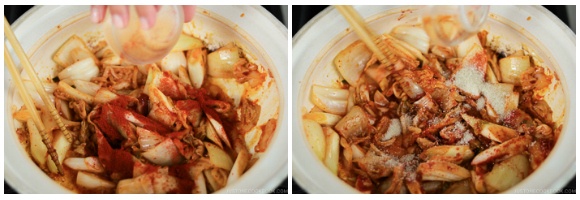
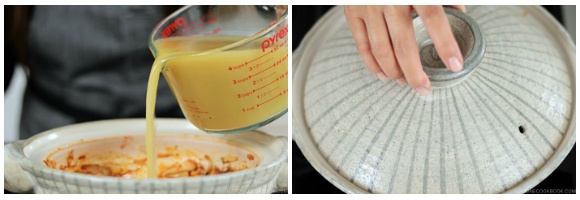

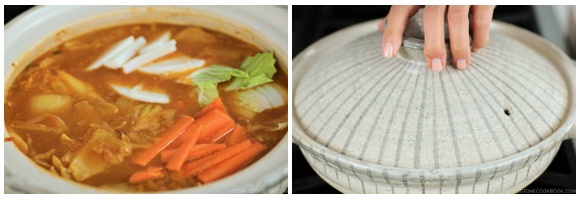
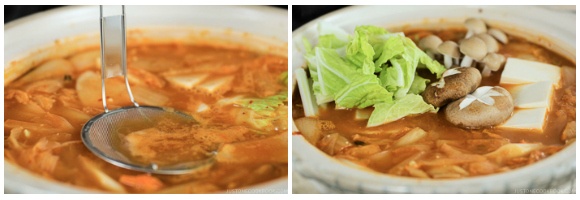
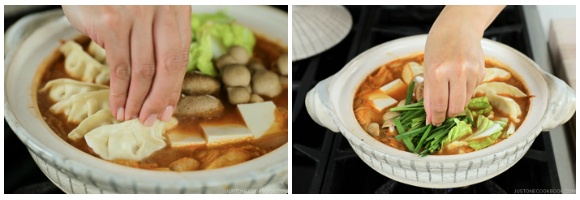
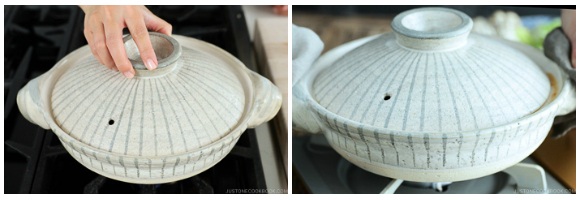

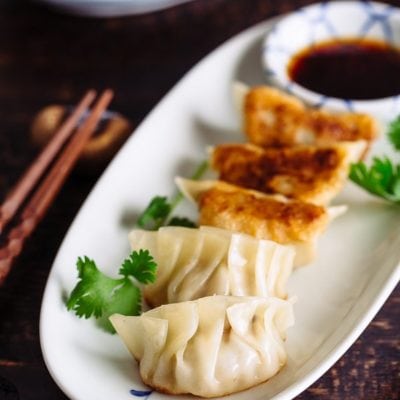
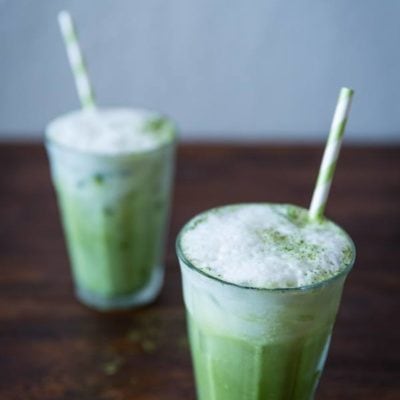

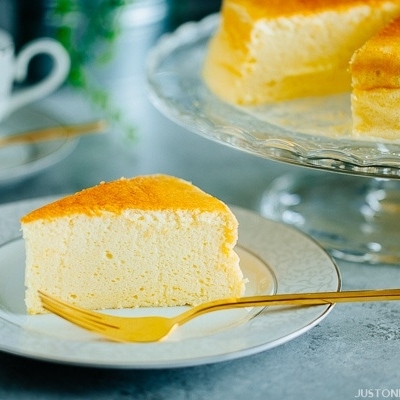
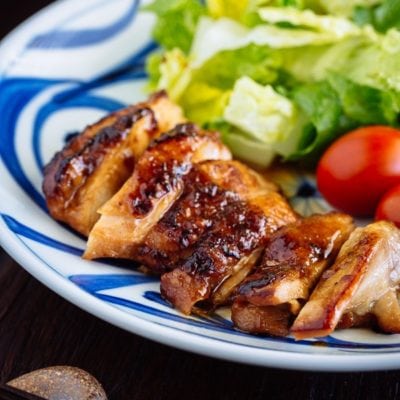
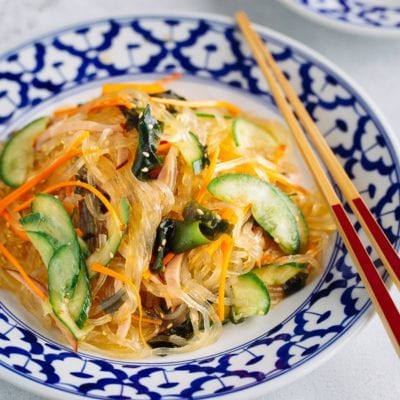
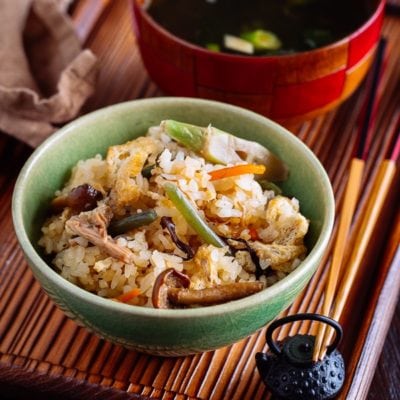
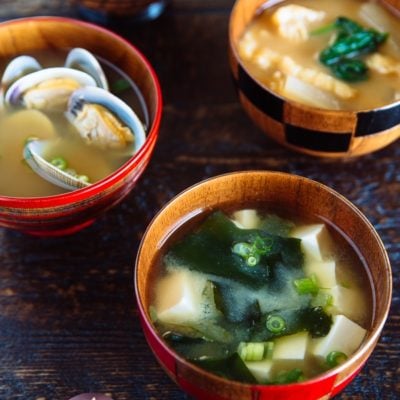
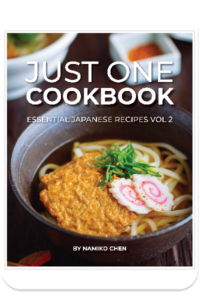
This was incredible! I dug in thinking that the gyoza would be the star, but it was the broth! It was pretty spicy for me, so I made it a little creamier with a slice of processed cheese. Instant comfort food! There is enough for another big round even after I had a refill.
Hi Meghan! I’m happy you liked the dish! This is probably a bit more tamed version compared to the authentic Korean version. Korean foods in Japan are all less-spicy one. 😀 Thanks so much for trying this recipe! xo
What kind of miso? Shiro? Aka?
Hi Frank! Use whatever you have in your fridge for this recipe. I did not want to specify and make everyone buy a specific kind of miso. I personally use many different types of miso and make the same dish with different miso. I only specify when it has to be a certain kind. 🙂
Here’s my favorite miso: https://www.justonecookbook.com/miso/
I have a clay pot without a lid. Will using a glass lid (I have one that fits the clay pot pretty well) rather than the traditional clay lid affect the quality of the food I cook?
Hello t! Nope, you’re okay using a glass lid. What happened to the lid? Did it break? 🙁 It won’t affect cooking at least, and you will see how the food is being cooked through a glass lid. 😉
I made this sans kimchi, gochujang, and gochugaru. It was still fantastic though! I was a little worried about the dashi I used (I picked a packet from Mitsuwa) because in general I don’t like bonito flakes, and it was my first time eating negi, but everything came together beautifully. My partner and I actually ate almost all of it … well, it’s mostly vegetables, so how bad can that be? Thanks so much for sharing your recipes! I’ve learned to cook so many new things thanks to your blog. 🙂
Quick question–do you have any recommendations for a grill I could use to keep my hot pot warm once it’s on the table?
Hi Max! Thank you so much for trying this recipe and for your kind feedback! I’m so thrilled to hear you and your partner enjoyed this dish! 🙂
I recommend ones I use for my blog and home use:
– Iwatani portable butane burner: https://amzn.to/2lV73un (there are less expensive style as well)
– Canister: https://amzn.to/2mc7mDy
Hi, what size of donabe do you use?
Hi JR! The diameter of my donabe is 10 inches (inner is 8 inches), and 2.5 inches tall. Hope that helps! p.s. I updated the name. 🙂
Thank you!! 😀
Your donabe is so cute! What brand is it?
Hi Christopher! I got it from Toiro when I was in Los Angeles. Mine is medium size: https://toirokitchen.com/collections/all/products/rikyu-tokusa.
I have a double lid rice cooker donabe I got from Toiro and am buying a classic style one as well. What size is yours? I’m not sure which size to buy to make recipes like this for the 4 of us. 10.5″ or even larger? Thanks so much!
Hi Mika! This donabe size is 10.5″ in diameter (the inner circle is 8.5″). Hope that helps! 🙂
Thank you! I have a 12″ on the way. I wanted to make sure it was big enough for anything! lol I’m making this on Saturday night. 😉
Hope you enjoy the recipe and cooking in donabe!
What a wonderful dish! Quick, easy, satisfying and delicious, What more could you ask for.
I just found your site and have made a few dishes and all have been great. The site also includes great information regarding Asian food culture, which I love. thank you!
Hi Carl! Welcome to JOC! And thank you so much for your kind words. We hope you enjoy all the recipes on our site. 🙂
I just made this for dinner last night! It was so delicious. The spice level was perfect and made it extra warming for a cold fall night. I currently only have a small donabe so I cut the recipe in half and then put some extra veggies and gyoza on a plate to add as we ate. It was actually quite a lot of food. It was enough for me and my partner to share for dinner with enough leftovers for my partner to take for lunch the next day. We will definitely be making this again!
Hi Mei! Thank you for trying this recipe and for your kind feedback! Haha sorry maybe we eat a lot (serving size is too big)… xD Glad it wasn’t too spicy for you too. It’s very tamed Japanese version spiciness. 😉
Just made this! So delicious. I even made the gyoza and wrappers following your recipe. Not a scrap left and there were only three of us! Lol!!!
Hi Kate! Aww I’m so happy to hear you enjoyed this recipe and you even made gyoza AND gyoza wrappers too! WOW, very impressive!!! Thank you for your kind words and feedback. 🙂
I am a flight attendant and fly to Japan. I a rest. there I buy Korean soup. This sounds very much like what I buy (except for the Kimchee) The soup is very hot with pepper. School children (teenagers) buy this very large bowl and enjoy also. I am going to try to make this thank you
Hi Elaine! Hope you enjoy this recipe! It’s easy and fulfilling, especially on cold days!
Just wanted to let you know – I have been making many of your recipes now for several months and have never been disappointed. Your attention to detail (I assume that is a Japanese trait) is astonishing and refreshing. It certainly helps this engineer to follow your recipes!
This dish is fabulous. Just one note – it made enough for 4 people, not sure why it is listed as “Serves 2”. No matter – we almost finished it all 🙂
Hi Waldo! Thank you so much for your kind feedback and I’m so happy to hear you are enjoying my recipes! Your compliment really made me happy. 🙂
Oh!!! It was more like nabe/soup dish and it can be 2-3 serving. However, this recipe plugin doesn’t allow me to give range… so I did for 2 (American size). You can definitely serve for 4 too. 🙂
Tried this receipe and my family loved it! Especially its winter time and the spicy hearty soup kept us warm. Will be having it again soon and maybe add in thinly sliced pork belly and Korean rice cake.
Hi Jeannie! Thank you so much for trying this recipe! I’m so happy to hear you enjoyed it. Add whatever you think it’ll work (pork belly and rice cake sound perfect!). 🙂
Do you think this would still be delicious without kimchi? I love kimchi but unfortunately my boyfriend isn’t a huge fan…
Hi Ellen! Sure! You can add more miso and make it iso flavor. 🙂
Huge and tasty fusion fun Japanese-style with Korean overtones. Like the soupy version of a Chinese stirfry which also makes one use one’s imagination 🙂 ! Absolutely love any meals cooked and eaten together whilst the music plays and conversation flows . . .
Hi Eha! Thank you! I especially love hot pot because my job is chopping and prepping the ingredients. 😀 Ha! Thank you for your kind comment, Eha! xoxo
This recipe looks so good. I have one clarifying question.. Can you confirm that the cabbage is 4-6 lbs (you left off the weight)?
Hi Keith! SO sorry! I think somehow the recipe card didn’t get updated. I added the info – it should be 4-6 leaves. 🙂